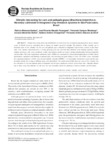Use este identificador para citar ou linkar para este item:
http://www.alice.cnptia.embrapa.br/alice/handle/doc/963267Registro completo de metadados
| Campo DC | Valor | Idioma |
|---|---|---|
| dc.contributor.author | SANTOS, P. M. | pt_BR |
| dc.contributor.author | PEZZOPANE, J. R. M. | pt_BR |
| dc.contributor.author | MENDONÇA, F. C. | pt_BR |
| dc.contributor.author | BETTIOL, G. M. | pt_BR |
| dc.contributor.author | EVANGELISTA, B. A. | pt_BR |
| dc.contributor.author | SILVA, F. A. M. da | pt_BR |
| dc.date.accessioned | 2013-08-02T11:11:11Z | pt_BR |
| dc.date.available | 2013-08-02T11:11:11Z | pt_BR |
| dc.date.created | 2013-08-02 | pt_BR |
| dc.date.issued | 2012 | pt_BR |
| dc.identifier.citation | Revista Brasileira de Zootecnia, v. 41, n. 1, p. 36-40, 2012. | pt_BR |
| dc.identifier.uri | http://www.alice.cnptia.embrapa.br/alice/handle/doc/963267 | pt_BR |
| dc.description | Climatic risk zoning allows the identification of areas of low risk of reduced crop productivity due to climatic events. In Brazil, losses to agriculture due to climate are mainly caused by drought. The objective of this research was to determine areas of low climatic risk for corn and palisade grass cultivated in integrated crop-livestock systems in Sao Paulo state. Corn varieties characterized by a 120-day growing cycle and soil with three different water holding capacities (sandy, medium and clayey soils) were considered. A daily water balance model was used to simulate planting dates between September and December. The water requirement satisfaction index (WRSI) was calculated for critical phenological phases of both cultures (germination, emergence and tillering of palisade grass and flowering and grain filling of corn). The WRSI values, calculated for a minimum frequency of 80%, were located spatially using the SPRING v. 5.1 geographic information system and the most favorable periods for sowing in different areas were determined. The results showed that there are areas of low climatic risk for cultivation of corn and palisade grass in integrated crop-livestock production systems in Sao Paulo state. Although climatic risk in these areas also depends on soil type, the most favorable period for planting is between October and November. | pt_BR |
| dc.language.iso | por | pt_BR |
| dc.rights | openAccess | pt_BR |
| dc.subject | Integrated crop-livestock | pt_BR |
| dc.subject | Production systems | pt_BR |
| dc.subject | Rainfall | pt_BR |
| dc.subject | Integração Lavoura-pecuária | pt_BR |
| dc.subject | Pasture | pt_BR |
| dc.title | Climatic risk zoning for corn and palisade grass (Brachiaria brizantha cv. Marandu) cultivated in integrated crop-livestock systems in São Paulo state, Brazil. | pt_BR |
| dc.type | Artigo de periódico | pt_BR |
| dc.date.updated | 2019-04-26T11:11:11Z | pt_BR |
| dc.subject.thesagro | Milho | pt_BR |
| dc.subject.thesagro | Pastagem | pt_BR |
| dc.subject.thesagro | Zoneamento Agrícola | pt_BR |
| dc.subject.nalthesaurus | agricultural zoning | pt_BR |
| dc.subject.nalthesaurus | corn | pt_BR |
| dc.subject.nalthesaurus | evapotranspiration | pt_BR |
| dc.subject.nalthesaurus | water balance | pt_BR |
| riaa.ainfo.id | 963267 | pt_BR |
| riaa.ainfo.lastupdate | 2019-04-26 -03:00:00 | pt_BR |
| dc.identifier.doi | http://dx.doi.org/10.1590/S1516-35982012000100006 | pt_BR |
| dc.contributor.institution | PATRICIA MENEZES SANTOS, CPPSE; JOSE RICARDO MACEDO PEZZOPANE, CPPSE; FERNANDO CAMPOS MENDONÇA, ESALQ-USP/PIRACICABA; GIOVANA MARANHAO BETTIOL, CPPSE; BALBINO ANTONIO EVANGELISTA, CPAC; FERNANDO ANTONIO MACENA DA SILVA, CPAC. | pt_BR |
| Aparece nas coleções: | Artigo em periódico indexado (CPAC)  | |
Arquivos associados a este item:
| Arquivo | Descrição | Tamanho | Formato | |
|---|---|---|---|---|
| santospm012012.pdf | 276,88 kB | Adobe PDF |  Visualizar/Abrir |









